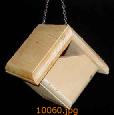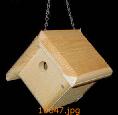
   |
 |
|
|
Wren Houses
|
||||||||||||||||||||||||||||||||||||||||||||||||||||||||||||
 Coveside Hanging Carolina Wren House
Coveside Hanging Carolina Wren House
The Carolina Wren, like the House Wren, doesn't mind a house that sways. The entrance is larger than that of the House Wren. The extra width gives Carolina Wrens the ability to carry wide sticks into their house for nesting material. Hangs with a metal chain and opens easily for clean-out. (7-1/2"h x 7-3/4"w x 7-1/2"d) |
 Coveside Hanging Wren House
Coveside Hanging Wren House
Most birds prefer a stable house, but House Wrens don't mind a gentle movement. Hangs easily with the metal chain from a tree or bracket and opens easily for clean-out. RANGE: Breeds west across Canada to Washington and south to northern Georgia, Tennessee, northern Texas and southeastern Arizona. HABITAT: Thrives in residential areas, city parks, farmlands and woodland edges. (7-1/2"h x 7-3/4"w x 7-1/2"d) |
 Coveside House Wren House
Coveside House Wren House
With its 1" entrance hole, this house provides great protection for house wrens. Wrens are very protective, so position the nest box in less frequented areas or you might get a scolding from a disgruntled parent. RANGE: Breeds west across Canada to Washington and south to northern Georgia, Tennessee, northern Texas and southeastern Arizona. HABITAT: Likes residential areas, city parks, farmlands, woodland edges. (12-1/2"h x 6"w x 8-1/2"d) |
 Coveside Slate Squirrel Guard
Coveside Slate Squirrel Guard
This guard is used with the following nesting houses: Window Nest Box, Chickadee, Nuthatch, Titmouse, House Wren, all Bluebird Houses, Saw-Whet Owl and Kestrel. This guard will protect the box from chewing squirrels. |
 Coveside Wood Chips Nesting Material
Coveside Wood Chips Nesting MaterialNesting Material. Gallon size. |
|
Ads by Google |

Home
Page |
Product Review Page | Help
 Woodside Gardens
The Registry of Nature Habitats
Woodside Gardens
The Registry of Nature Habitats 
 1999 -
1999 -
All Rights Reserved
Last Updated:
